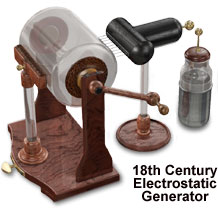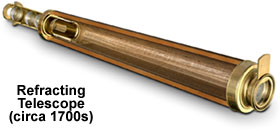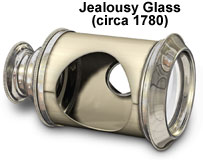
|
1700-1799
With Isaac Newton in the lead, the scientific revolution sparked by Copernicus came to a close and the classic age of science began. The scientific method was formalized into a set of procedures that would standardize scientific inquiry. The foundations of physics, chemistry, and biology were established and, most importantly, scientists were finally able to conduct their studies unimpeded by church or state.

In 1704, Newton published Opticks, a consolidation of his writings and experiments on light, color, and optics and an exposition on his corpuscular theory of light. A masterpiece of experimental physics, this book not only elaborated on his previous work in optics, but showed how to use experiments to explore a subject. He explained how hypotheses could be used to prompt more experiments until enough information had been gathered to formally propose a theory. Opticks would serve as a model for the investigation of heat, light, electricity, magnetism, and chemistry well into the 1800s.
If there were any lingering thoughts about a changeless Earth-centered universe, they were nullified by new astronomical discoveries. In 1710, after comparing his star charts to those of the ancient Greeks, Edmund Halley discovered that the positions of the stars had changed in the 1800 years that had elapsed. Eighteen years later, James Bradley found that the stars' positions change from one time of year to another. These two observations could only be explained if the Earth rotated around the sun and by mid-century the geocentric theory was dead.

Telescopes and microscopes were both plagued by problems with color distortions and poor image quality, but were refined and improved throughout the 1700s. A significant development for both devices was the invention of the achromatic lens in 1733 by Chester Moor Hall. These lenses, a pairing of a convex crown glass lens with a concave lens made of flint glass, eliminated many of the optical distortions common to the instruments of the time. Although invented first for the telescope, these lenses were adapted for use in the microscope by Benjamin Martin in 1774.
Astronomers were able to look deeper into the night and they found brand new mysteries to explore as they trained their telescopes to the sky. In 1781, William Herschel discovered what he thought was a new comet, a bright object previously thought to be a star. He named it Georgium Sidus, in honor of his patron, King George III, but then learned from an amateur astronomer in Germany, Wilhelm Olbers, that it was more likely to be a planet than a comet. Olbers had recently developed a new way to calculate the orbits of comets, and this object, while it moved, did not follow the same kind of orbit as comets. The first planet discovered since antiquity, Georgium Sidus was renamed Uranus in 1850.

An auspicious discovery in this century was the relationship between lightning and electricity, as demonstrated by Benjamin Franklin's famous kite-flying experiment in 1752. This and other experiments convinced Franklin that all materials possessed some kind of electrical "fluid." In England, William Watson independently came to the same conclusion. Studies like these set the stage for nineteenth century investigations into the nature of light, electricity, and magnetism and the discovery that light is an electromagnetic phenomenon.
| 1700 - 1799 |
| 1704 |
Isaac Newton (England) publishes Opticks, his collection of papers relating to light, color, and optics. It includes a thorough exposition of a corpuscular theory of light and analysis of the white light spectrum. |
| 1710 |
Edmund Halley (England) establishes that the positions of the stars in the night sky are changing over time. He also devises a theory about the orbits of comets, including his namesake, Halley's Comet. |
| 1725 |
Edmund Culpeper (England) introduces a new microscope design, reverting to the original three-legged microscope, but mounted on a stage raised above table level. A concave mirror was inserted below the stage, enabling a specimen to be conveniently lit from below. |
| 1728 |
English astronomer James Bradley announces his discovery that some stars vary slightly in their position from one time of year to another. He also uses measurements from his study to confirm that the speed of light is finite and determines it to be 183,000 miles (295,000 kilometers) per second. |
| 1733 |
Chester Moor Hall (England) invents the achromatic lens for telescopes, which eliminates many optical distortions by combining a convex crown glass lens with a concave lens made of lead-based flint glass. |
| 1738 |
Johannes Nathaniel Lieberkuhn (Germany) invents a reflective attachment (speculum) for microscopes. Made of polished metal, it increases the amount of light illuminating a specimen. |
| 1738 |
Benjamin Martin, an English instrument maker, develops the "First Universal Microscope," a portable and versatile microscope. He later designs a small simple microscope he calls the "pocket reflecting microscope." Later it is called the drum microscope and becomes very popular, remaining so throughout most of the 1800s. |
| 1742 |
English optics expert John Cuff designs a versatile, easy-to-use compound microscope that is promoted and popularized by the publication of a book by Henry Baker, The Microscope Made Easy. This design remains popular throughout the 1800s. |
| 1750 |
John Cuff designs and builds a simple, low power, dissecting microscope for the study and dissection of aquatic specimens. |
| 1752 |
Thomas Melvil (Scotland) observes bright lines in spectra of flames when introducing different elements to the flame. |
| 1752 |
Benjamin Franklin (USA) performs a series of experiments, including the celebrated kite flying experiment, and establishes that lightning is an electrical phenomenon. |
| 1758 |
John Dollond (England) reinvents the achromatic lens and receives a patent for the design. |
| 1761 |
Johann Heinrich Lambert (Germany) introduces the term "albedo" in order to describe the differing reflective properties of planets. |
| 1772 |
French mineralogist Jean-Baptiste Romé de l'Isle publishes his Traitise on Crystallography in which he confirms that the angles between corresponding faces are always the same. In addition, he shows that these angles are always characteristic of the particular mineral. |
| 1779 |
Wilhelm Olbers, a German physician and astronomer, devises a new method for calculating the orbits of comets. |
| 1781 |
German born, British astronomer William Herschel discovers the first new planet since prehistory, but believes it to be a comet. He names it Georgium Sidus, in honor of his patron, King George III. |
| 1781 |
Wilhelm Olbers uses his new method for calculating the orbits of comets to determine that Herschel's comet, Georgium Sidus, isn't a comet at all, but a planet. In 1850 it is renamed Uranus. |
| 1782 |
John Goodricke, an English astronomer, observes that the brightness of the star Algol fluctuates with a regular periodicity and proposes that it is being partially eclipsed by a body within its orbit. He is also the first to describe a Cepheid variable star (Delta Cephe). Although he is deaf, Goodricke accomplishes a great deal during his brief 21-year life. |
| 1786 |
Caroline Herschel (Germany/England), sister of astronomer William Herschel, discovers her first comet. She continues to record her brother's observations, but over the years establishes her own scientific career for which the Royal Astronomical Society awards her a gold medal by in 1828. |
| 1789 |
William Herschel (Germany, England) finishes building an optical reflecting telescope in Slough, England. Considered one of the technical wonders of the century, it has a metal mirror 122 centimeters (49 inches) in diameter with a focal length of 12 meters (40 feet). |
| 1790 |
French engineer Claude Chappe invents the semaphore visual telegraph. His system uses a series of signaling stations mounted on high locations, with two-armed semaphores for signaling and telescopes for viewing signals from other stations. |
| 1791 |
A self-educated astronomer, Benjamin Banneker (USA) develops calculations predicting eclipses and lunar phases. Using this information, he publishes a combination almanac and ephemeris until 1802. |
|
|
 |
 |
 |
BACK TO TIMELINE IN OPTICS HOME
Questions or comments? Send us an email.
© 1995-2025 by
Michael W. Davidson
and The Florida State University.
All Rights Reserved. No images, graphics, software, scripts, or applets may be reproduced or used in any manner without permission from the copyright holders. Use of this website means you agree to all of the Legal Terms and Conditions set forth by the owners.
This website is maintained by our
Graphics & Web Programming Team
in collaboration with Optical Microscopy at the
National High Magnetic Field Laboratory.
Last Modification Friday, Nov 13, 2015 at 01:18 PM
Access Count Since August 1, 2000: 71911
Visit the websites of our partners in education:
|



